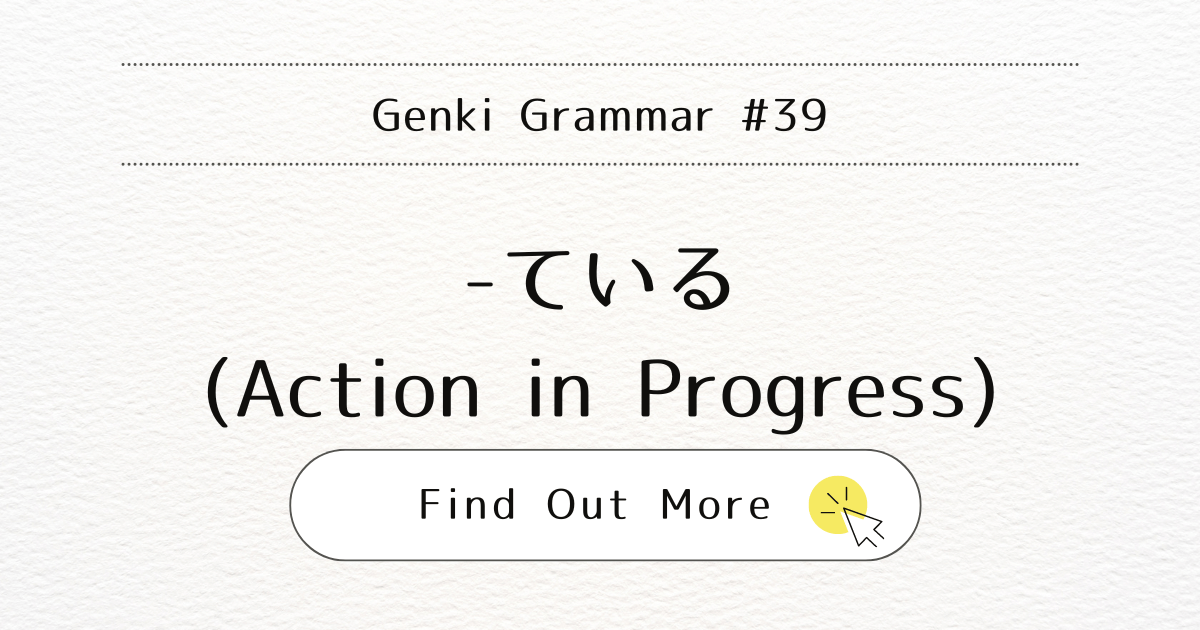
Introduction
In this post, we will learn how to use the verb te-form together with the helping verb いる (iru) to describe actions in progress. Understanding the types of Japanese verbs is essential for using this structure correctly.
What It Means
Japanese verbs can be classified into three types:
- Verbs that describe activities that last for some time ((e.g., 食べる (taberu), 読む (yomu))
- Verbs that describe changes that are more or less instantaneous (e.g., 死ぬ (shinu), 起きる (okiru))
- Verbs that describe continuous states (e.g., ある (aru), いる (iru))
You can use verbs in the first group, such as 食べる (taberu) and 読む (yomu), in their te-form with the helping verb いる (iru) to describe actions in progress. Verbs of the second type will be discussed in the next post: – teiru (Result of a Change), and the third type does not use ている (teiru).
When You Use It
Use the te-form with いる (iru) to describe actions that are currently happening. This structure is also used to describe habitual actions or what someone does by occupation.
Examples
- マリアさんは今勉強しています。(Maria-san wa ima benkyou shiteimasu.) – Maria is studying right now.
- りくさんは英語の本を読んでいます。(Riku-san wa eigo no hon o yondeimasu.) – Riku is reading a book in English.
- 今、何をしていますか。(Ima, nani o shiteimasu ka?) – What are you doing right now?
You can also use a -ています (-teimasu) sentence to describe habitual actions or someone’s occupation. For example:
- 私は英語を教えています。(Watashi wa eigo o oshieteimasu.) – I teach English / I am teaching English (right now).
- マリアさんは毎日日本語を勉強しています。(Maria-san wa mainichi nihongo o benkyou shiteimasu.) – Maria studies Japanese every day.
Note
- The helping verb いる (iru) conjugates as a ru-verb. Here are some examples:
Present
- Affirmative: 食べています (tabeteimasu) – He is eating
- Negative: 食べていません (tabeteimasen) – He is not eating
Past
- Affirmative: 食べていました (tabeteimashita) – He was eating
- Negative: 食べていませんでした (tabeteimasen deshita) – He was not eating
2. In most cases, you can determine whether a verb is an activity or a change verb by checking if the verb allows for a phrase describing duration, such as 1時間 (ichijikan). For example:
- 私はきのう1時間本を読みました。(Watashi wa kinou ichijikan hon o yomimashita.) – I read a book for an hour yesterday.
- 私は1時間死にました。(Watashi wa ichijikan shinimashita.) – I died for an hour (this is ungrammatical and odd).
読む (yomu) is thus an activity verb, and 死ぬ (shinu) is a change verb.
3. The distinction between いる (iru) and ある (aru) that we learned in a previous post does not apply to the helping verb -ている (-teiru). You can use -ている (-teiru) for both living things and inanimate objects.
Conclusion
Using -ている (-teiru) to describe actions in progress helps you express what is happening right now or habitual actions in Japanese.



